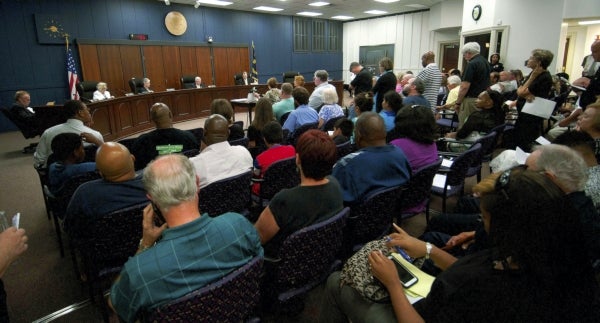Josh Bergeron: Divisiveness can’t define debate
Published 12:01 am Sunday, June 16, 2019

- People line up in 2015 to speak at a public comment period. (Jon Lakey/Salisbury Post)
Should divisive matters be ignored?
About three months ago, a group visiting the Salisbury Post sparked a vigorous debate over placement of a story on our front page.
The headline “‘Fame’ monument again splattered with paint” spanned the width of page 1A in large, bold type and rightfully so. It was the second time in seven months the monument had been defaced. And, as of this column’s writing, the vandals have not been charged.
But in that March meeting, one man passionately spoke about the division that publicizing the vandalism on the front page would cause. The couple dozen participants had been asked to judge whether we had appropriately placed stories in the right spots using a set of “news values.”
The man’s loud appeal was echoed by a few others in the group. Perhaps we shouldn’t have written about the monument’s vandalism at all because of the division it will cause, some members of the group said.
That debate about news coverage looks similar to the one playing out about the monument itself.
Mayor Al Heggins’ reasons for starting up the latest round of debate is that she hopes to prevent a public safety crisis and another incident of vandalism.
Those with strongly held beliefs have only grown more steadfast in their position as the Salisbury City Council again has scheduled debate on the matter. For some, the monument is racially divisive, represents an ugly stain in our country’s past, has produced two incidents of vandalism and should be moved. To others, it’s racially divisive, sits on private property, is protected by state law and is best left untouched. Some version of the same debate will again take place during Monday’s special Salisbury City Council meeting at the Civic Center.
There’s no need to debate the matter because of larger problems in our community and the division it would cause, some say. But we cannot be satisfied to let our division over the matter fester in silence. An understanding of the range of opinions held by those who live, work, play and pray in Salisbury will help inform the City Council’s decision-making process and citizens of the opinions shared by their neighbors and strangers. Not being informed about the world and beliefs of people that surround us decreases the degree to which we are a community ever so slightly, bringing us closer to simply being a collection of people who live in the same place.
The solutions mentioned in letters to the editor, opinion columns and other submissions since the March vandalism are something like the following:
• Leave it where it is with no changes of any kind.
• Leave it where it is and erect something providing new context.
• Remove it and relocate it to a less prominent location.
• Remove it and place it in a museum.
One idea proposed in Betty Jo Hardy’s letter to the editor published Thursday (“Solution to ‘Fame’ controversy waiting in Alabama”) caught my attention.
In Montgomery, Alabama, the Equal Justice Initiative in 2018 opened the National Memorial for Peace and Justice in part to provide a site where people can reflect on the history of racial injustice, including lynchings.
The structure at the center of the memorial contains 800 steel monuments for each county in the U.S. where a lynching took place. Names of those lynched are engraved on the monuments, and a group of identical monuments are waiting to be claimed by the counties they represent, the Equal Justice Initiative says.
“Our nation’s history of racial injustice casts a shadow across the American landscape,” EJI Director Bryan Stevenson said in a news release. “This shadow cannot be lifted until we shine the light of truth on the destructive violence that shaped our nation, traumatized people of color and compromised our commitment to the rule of law and to equal justice.”
And while the claiming process has not started yet, EJI said, communities can now express interest and be included on updates about when placement could occur.
As Hardy wrote, perhaps the lynching monument is part of the solution if the council chooses to leave the monument where it is and provide additional context.
Stay, go or something in between, we cannot halt conversations about “Fame” simply because they will be difficult.
Josh Bergeron is editor of the Salisbury Post.

